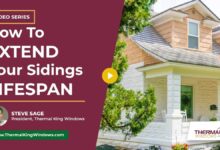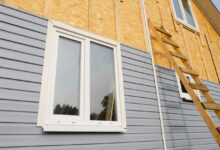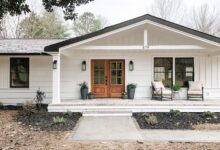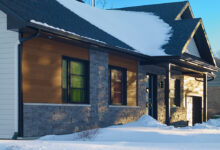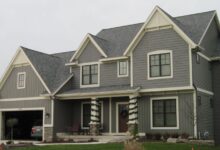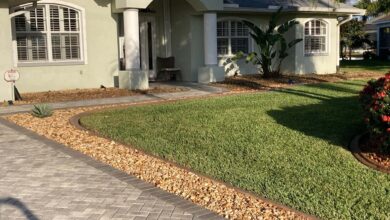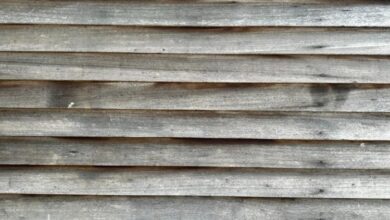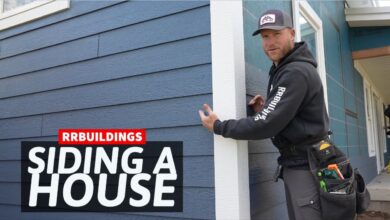Metal Siding for Modern Residential Properties
Metal Siding for Modern Residential Properties offers a compelling blend of durability, aesthetics, and sustainability. This increasingly popular cladding choice presents homeowners with a diverse range of options, from sleek minimalist designs to charming farmhouse aesthetics, all while boasting exceptional longevity and energy efficiency. Understanding the various types of metal siding, their installation processes, and long-term maintenance is key to making an informed decision for your modern home.
This exploration delves into the multifaceted world of metal siding, covering everything from material properties and cost considerations to design choices and environmental impact. We’ll examine the advantages and disadvantages compared to other cladding materials, providing you with a comprehensive understanding to help you determine if metal siding is the right choice for your project.
Material Properties and Durability
Metal siding offers a compelling blend of aesthetics and longevity for modern residential properties. Its durability stems from the inherent properties of the metal itself, but the lifespan and maintenance requirements vary significantly depending on the type of metal and the applied coatings. Understanding these factors is crucial for making an informed decision about siding choice.
Metal Siding Lifespan and Maintenance
The lifespan of metal siding is heavily influenced by the base material and the quality of its finish. Aluminum siding, known for its lightweight nature and corrosion resistance, typically lasts 30-50 years with minimal maintenance. Steel siding, while potentially stronger and more dent-resistant, boasts a similar lifespan provided it has a high-quality coating to prevent rust. Zinc siding, prized for its self-healing properties and unique patina, can last even longer—potentially exceeding 100 years—though its initial cost is higher. Regular cleaning with a mild detergent and water, along with occasional inspections for damage, are key maintenance tasks for all types of metal siding. Prompt attention to scratches or dents can prevent further deterioration and prolong the siding’s life.
Weather Resistance of Metal Sidings
Metal siding excels in withstanding various weather conditions. Aluminum, steel, and zinc all exhibit high resistance to rain and snow, shedding water effectively and preventing moisture penetration. However, the susceptibility to hail damage varies. Thicker gauge steel siding generally offers better hail resistance than thinner aluminum. All metal sidings are resistant to rot and insect infestation, unlike wood siding. While all metals resist sun damage to a degree, the quality of the coating plays a crucial role. UV-resistant coatings are essential for preventing fading and degradation from prolonged sun exposure. Regular cleaning helps remove dirt and grime that can accelerate degradation from UV radiation.
Impact of Coatings and Finishes
The coating applied to metal siding significantly impacts its longevity and aesthetic appeal. Kynar and PVDF (polyvinylidene fluoride) coatings are considered premium options, offering exceptional UV resistance, color retention, and durability. These coatings are highly resistant to fading and chalking, ensuring the siding maintains its appearance for many years. Less expensive coatings, while potentially providing adequate protection initially, may be more susceptible to fading, chipping, and degradation over time, requiring more frequent maintenance or replacement. The choice of finish—such as smooth, textured, or embossed—can also affect the siding’s overall performance and appearance. Textured finishes can sometimes offer better protection against minor scratches. The selection of the coating and finish should be carefully considered to ensure the siding meets the desired aesthetic and performance requirements.
Aesthetic Considerations and Design Options
Metal siding offers a surprisingly diverse range of aesthetic possibilities, moving far beyond the utilitarian image it might once have held. Modern manufacturing techniques and a wider palette of colors and finishes allow homeowners to integrate metal siding seamlessly into a variety of architectural styles and personal preferences, creating a visually appealing and durable exterior.
Color and Finish Options for Metal Siding
The availability of colors and finishes for metal siding is extensive. Beyond the traditional muted tones, homeowners can now choose from a vibrant spectrum, including bold jewel tones, earthy neutrals, and even metallic shades that reflect light in interesting ways. Finishes range from smooth, matte surfaces to textured options that mimic the appearance of wood, stucco, or even stone. Powder-coated finishes are common, offering superior durability and color retention. Kynar 500® is a popular high-performance fluoropolymer coating known for its exceptional longevity and resistance to fading and chipping. These varied options allow for considerable creative freedom in achieving the desired aesthetic.
Metal Siding and Architectural Styles
Metal siding’s versatility extends to its compatibility with various architectural styles. Its clean lines and modern aesthetic make it a natural fit for minimalist designs, where simplicity and functionality are paramount. Imagine a sleek, charcoal-grey metal siding on a contemporary home with large windows and a flat roof – the result is a striking, cohesive look. Conversely, metal siding can also enhance farmhouse aesthetics. A warm, rustic brown or deep green, perhaps with a slightly textured finish to mimic wood grain, can contribute to a cozy, inviting feel. Similarly, mid-century modern homes benefit from metal siding’s ability to blend clean lines with a touch of boldness. A muted blue or olive green, paired with clean horizontal lines, can complement the architectural features beautifully, creating a timeless appeal.
Visual Appeal of Different Panel Profiles
The choice of panel profile significantly impacts the overall visual effect of metal siding. Horizontal, vertical, and ribbed panels each create distinct impressions.
| Panel Profile | Visual Impression | Suitable Architectural Styles | Pros & Cons |
|---|---|---|---|
| Horizontal | Classic, traditional, emphasizes horizontal lines, can make a home appear wider. | Farmhouse, Ranch, Traditional | Pros: Widely available, cost-effective. Cons: Can appear less modern than vertical or ribbed. |
| Vertical | Modern, sleek, emphasizes height, creates a sense of verticality. | Modern, Minimalist, Contemporary | Pros: Modern aesthetic, can make a home appear taller. Cons: Can be more expensive than horizontal. |
| Ribbed | Textured, adds visual interest, can mimic other materials. | Various, adapts well to different styles | Pros: Adds dimension and texture, can create a unique look. Cons: May be more expensive, requires careful consideration of light reflection. |
Installation Process and Costs
Metal siding installation is a multi-stage process requiring skilled labor and attention to detail. Proper installation ensures the longevity and aesthetic appeal of your new siding, maximizing its protective and visual benefits. Understanding the steps involved and associated costs is crucial for effective budgeting and project management.
Installation Steps
The installation process begins with thorough preparation of the existing wall surface. This involves removing old siding, repairing any damaged sheathing or underlying structure, and ensuring a clean, level surface. Next, framing and furring strips are often installed to create a consistent plane for the new siding and allow for proper ventilation. Metal siding panels are then installed, typically overlapping each other to ensure water tightness. This process involves careful measuring, cutting, and fastening of panels to the prepared surface, adhering to manufacturer’s specifications. Finally, finishing touches include installing trim pieces, flashing around windows and doors, and caulking any gaps to create a weatherproof seal.
Cost Breakdown of Metal Siding
The cost of metal siding installation varies considerably depending on several factors. A typical cost breakdown might include:
| Component | Cost Range (USD per square foot) |
|---|---|
| Materials (Siding, Trim, Fasteners) | $2 – $10 |
| Labor (Preparation, Installation, Finishing) | $3 – $8 |
| Permits and Inspections | $100 – $500 (depending on location and project scope) |
These figures represent a broad range; the actual cost will be influenced by several factors. For instance, aluminum siding is generally less expensive than steel or zinc, while more intricate designs and larger properties will naturally increase costs.
Factors Influencing Overall Installation Cost
Several factors significantly impact the overall cost of metal siding installation. Property size is a primary driver; larger homes require more materials and labor, leading to higher expenses. The complexity of the design also plays a crucial role. Homes with many angles, dormers, or intricate architectural features require more precise cutting, fitting, and installation time, resulting in increased labor costs. The condition of the existing wall structure influences preparation costs; extensive repairs or replacements can significantly add to the overall budget. Finally, geographical location affects both material and labor costs. Areas with higher labor rates or limited access to specific materials will naturally lead to higher installation costs. For example, a simple 1500 sq ft ranch-style home in a rural area might cost significantly less than a similarly sized Victorian home in a major metropolitan area due to these varying factors.
Energy Efficiency and Sustainability
Metal siding offers a compelling combination of aesthetic appeal and environmental responsibility, particularly when considering its energy efficiency and sustainable attributes. Its performance in these areas often surpasses traditional materials like wood and vinyl, contributing to both reduced energy consumption and a smaller environmental footprint.
Metal siding’s inherent properties contribute significantly to a home’s energy efficiency. Its reflective surface minimizes heat absorption, keeping the interior cooler in summer and reducing the strain on air conditioning systems. Conversely, its thermal properties help retain heat during winter, lessening the demand on heating systems. This dual benefit translates to lower energy bills and a smaller carbon footprint compared to materials that absorb and radiate heat more readily, such as wood or dark-colored vinyl.
Insulation’s Role in Enhancing Energy Performance
Proper insulation is crucial in maximizing the energy-saving benefits of metal siding. While metal siding itself contributes to thermal performance through its reflective properties, the effectiveness is amplified considerably by installing a robust insulation system beneath the siding. This insulation layer acts as a barrier, preventing heat transfer between the exterior and interior environments. Common insulation materials include fiberglass batts, rigid foam boards, and spray foam insulation. The R-value of the insulation—a measure of its thermal resistance—directly impacts the overall energy efficiency of the home. A higher R-value indicates better insulation and, consequently, lower energy costs. For example, a home with R-15 wall insulation will experience significantly reduced energy consumption compared to one with R-7 insulation, regardless of the exterior siding material. The selection of insulation should consider the local climate and building codes to optimize energy performance.
Environmental Impact of Metal Siding Production and Disposal
The environmental impact of metal siding involves considerations at both the production and end-of-life stages. Manufacturing metal siding requires energy for the extraction, processing, and fabrication of the metal, primarily steel or aluminum. However, both steel and aluminum are highly recyclable materials, significantly reducing their environmental impact compared to materials requiring more energy-intensive production processes or less efficient recycling streams, such as vinyl. Furthermore, the durability of metal siding reduces the need for frequent replacements, extending its lifespan and minimizing the overall resource consumption over time. Responsible disposal and recycling programs are crucial in mitigating the environmental impact at the end of the siding’s life cycle. Many municipalities offer recycling programs for metal, allowing for the responsible recovery and reuse of the material, thus minimizing landfill waste. Choosing metal siding from manufacturers committed to sustainable practices and responsible sourcing can further enhance the overall environmental profile of this building material.
Maintenance and Repair
Metal siding, while durable, requires periodic maintenance to preserve its appearance and longevity. Regular cleaning and prompt attention to any damage will significantly extend its lifespan and maintain the aesthetic appeal of your home. Neglecting maintenance can lead to accelerated deterioration and costly repairs down the line.
Cleaning and Maintaining Metal Siding
Maintaining the cleanliness of your metal siding is crucial for preventing the accumulation of dirt, grime, and pollutants that can accelerate corrosion and damage the protective coatings. A simple, regular cleaning routine will help keep your siding looking its best and extend its life.
- Preparation: Begin by inspecting the siding for any loose or damaged panels. Address these issues before proceeding with cleaning. Gather your cleaning supplies, ensuring you have a sturdy ladder, garden hose with a nozzle, soft-bristled brush (or a pressure washer with a low-pressure setting), and a mild detergent specifically designed for exterior cleaning. Avoid harsh chemicals or abrasive cleaners that could scratch the siding’s surface.
- Pre-Rinse: Use the garden hose to thoroughly rinse the entire siding surface, removing loose dirt and debris. This pre-rinse helps to prevent scratching during the cleaning process.
- Cleaning Solution Application: Mix the mild detergent with water according to the product instructions. Apply the solution to the siding using a soft-bristled brush or a low-pressure setting on a pressure washer. Work in sections, ensuring even coverage.
- Scrubbing: Gently scrub the siding, paying attention to areas with heavy staining or buildup. Avoid excessive scrubbing, which can damage the protective coating.
- Rinsing: Thoroughly rinse the entire surface of the siding with clean water, ensuring all traces of the cleaning solution are removed. This step prevents water spots and ensures that no detergent residue remains.
- Drying: Allow the siding to air dry completely. Avoid using high-pressure water streams or harsh scrubbing which can damage the finish.
Common Issues and Repair Methods
While metal siding is resilient, damage can occur from impacts, severe weather, or general wear and tear. Identifying and addressing these issues promptly is key to preventing further damage and maintaining the structural integrity of your home’s exterior.
- Dents: Minor dents can often be repaired using a rubber mallet and a wooden block. Gently tap the dent from the back, working slowly to avoid further damage. For deeper dents, professional repair may be necessary.
- Scratches: Superficial scratches can often be touched up with a specialized metal siding paint that matches the existing color. For deeper scratches, replacement of the affected panel might be required.
- Rust: Rust is a common issue, particularly in areas with high humidity or salt spray. Remove loose rust with a wire brush and apply a rust converter or specialized metal primer followed by a touch-up paint. For extensive rust damage, panel replacement is recommended.
- Loose or Damaged Panels: Loose or damaged panels should be replaced immediately to prevent further damage and water intrusion. This usually requires removing the fasteners securing the panel and installing a new one, ensuring proper alignment and secure fastening.
Tools and Materials for Maintenance and Repair
Having the right tools and materials readily available will streamline the maintenance and repair process.
- Ladder: A sturdy ladder is essential for safe access to all areas of the siding.
- Garden Hose with Nozzle: For rinsing and cleaning.
- Soft-Bristled Brush or Low-Pressure Washer: For cleaning the siding.
- Mild Detergent: Specifically designed for exterior cleaning.
- Rubber Mallet and Wooden Block: For repairing minor dents.
- Metal Siding Paint: Matching the existing color, for touch-ups.
- Wire Brush: For removing rust.
- Rust Converter/Metal Primer: For treating rust.
- Screwdrivers and/or Drill: For replacing panels.
- Replacement Panels: To replace damaged sections.
Comparison with Alternative Cladding Materials
Choosing the right cladding material for a residential property is a significant decision, impacting both aesthetics and long-term costs. Metal siding offers a compelling set of advantages, but it’s crucial to weigh its pros and cons against other popular options like vinyl, fiber cement, and brick. This comparison will highlight key differences to aid in informed decision-making.
Metal siding, vinyl siding, fiber cement, and brick each present unique properties affecting their suitability for different projects and homeowner preferences. Factors such as budget, desired lifespan, maintenance requirements, and aesthetic appeal significantly influence the final choice. A detailed comparison across these factors will clarify the strengths and weaknesses of each material.
Cost Comparison of Cladding Materials
The initial cost of cladding materials varies significantly. Brick typically commands the highest price due to labor-intensive installation and material costs. Fiber cement falls in the mid-range, offering a balance between cost and performance. Vinyl siding is generally the most affordable option, while metal siding occupies a middle ground, depending on the type of metal and finish chosen. Long-term costs, including maintenance and repairs, should also be considered. For instance, while vinyl siding may have lower upfront costs, potential for damage and need for frequent replacement might offset initial savings.
Durability and Lifespan of Cladding Materials
Durability is a critical factor in cladding selection. Brick boasts exceptional longevity, often lasting for decades with minimal maintenance. Fiber cement also offers considerable durability, resisting rot, insects, and fire. Metal siding, particularly aluminum or steel with appropriate coatings, provides excellent resistance to damage from weather and impact, lasting for many years. Vinyl siding, while relatively inexpensive, is susceptible to damage from impacts and extreme weather, leading to shorter lifespan compared to other options. A house clad in brick in a historic district might last for over a century with proper maintenance, showcasing the material’s remarkable durability, while a vinyl-clad house might need replacement after 20-30 years depending on climate and maintenance.
Aesthetic Considerations and Design Options for Cladding Materials
Aesthetic preferences heavily influence cladding choices. Brick offers a classic, timeless look, available in a range of colors and textures. Fiber cement provides versatility, mimicking the appearance of wood or stone. Metal siding offers a modern, clean aesthetic, available in various colors and finishes, from sleek, contemporary styles to more traditional profiles. Vinyl siding offers a wide array of colors and styles, often mimicking other materials, but can sometimes appear less refined than other options. The choice depends on the overall architectural style of the home and the homeowner’s personal taste. A modern farmhouse might pair well with metal siding, while a Victorian-style home might be better suited to fiber cement or brick.
Comparative Table of Cladding Materials
| Material | Cost (Relative) | Durability | Aesthetics |
|---|---|---|---|
| Brick | High | Very High | Classic, Timeless |
| Fiber Cement | Medium | High | Versatile, Mimics other materials |
| Metal Siding | Medium | High | Modern, Clean, Customizable |
| Vinyl Siding | Low | Low to Medium | Wide variety of colors and styles |
Building Codes and Regulations
Metal siding installation, while seemingly straightforward, is subject to a complex web of local, state, and sometimes even national building codes and regulations. These regulations are designed to ensure public safety, structural integrity, and energy efficiency. Understanding and adhering to these codes is crucial for homeowners and contractors alike.
The importance of obtaining the necessary permits before commencing any metal siding installation cannot be overstated. Permits serve as official documentation that the project adheres to established building codes and safety standards. They also provide a layer of legal protection for both the homeowner and the contractor. Without permits, homeowners risk significant fines and potential legal repercussions, while contractors could face license suspension or revocation.
Permitting Requirements
Securing the necessary permits typically involves submitting detailed plans of the project to the local building department. These plans should include specifications for the type of metal siding, the installation method, and any structural modifications required. Inspectors will review these plans to ensure compliance with local codes before issuing a permit. The specific requirements for permits can vary significantly depending on location, project scope, and the type of metal siding used. For instance, a large commercial project will require a far more extensive permit application than a small residential project. Failure to obtain the correct permits can lead to delays, costly revisions, and potential project shutdowns.
Consequences of Non-Compliance
Non-compliance with building codes related to metal siding installation can have severe consequences. These consequences can range from relatively minor infractions, such as requiring corrections before final inspection, to more serious issues such as fines, legal action, and even the demolition of non-compliant structures in extreme cases. For example, improper installation leading to water damage or structural weakness could result in substantial financial penalties and potential legal disputes. Insurance companies may also refuse to cover damages resulting from non-compliant installations. In addition, resale value of a property can be significantly impacted if it has known building code violations. It is therefore essential to prioritize compliance throughout the entire process.
Specific Code Examples
While specific codes vary by jurisdiction, common areas of regulation include wind load resistance, fire safety (especially concerning the use of combustible materials near the siding), and proper ventilation to prevent moisture buildup. For example, International Building Code (IBC) sections often address exterior wall cladding, specifying requirements for wind pressure resistance and detailing the appropriate methods for fastening materials to prevent damage in high-wind areas. Similarly, local fire codes might dictate the necessary spacing between the siding and any combustible materials to mitigate fire risk. These codes are regularly updated to reflect advancements in building technology and safety standards.
Case Studies of Modern Residential Properties
Metal siding’s versatility and durability make it an increasingly popular choice for modern residential architecture. The following case studies showcase diverse applications of metal siding, highlighting its aesthetic potential and homeowner satisfaction. Each example illustrates how different metal types and design approaches can achieve unique and visually striking results.
Modern Farmhouse with Zinc Siding
This property, located in rural Vermont, features a modern interpretation of a classic farmhouse design. The homeowners opted for zinc siding, appreciating its natural weathering patina that will develop over time, creating a unique and beautiful character. The overall design incorporates large windows to maximize natural light, coupled with a simple, clean-lined aesthetic. The dark grey zinc siding provides a striking contrast against the white trim and creates a sophisticated yet rustic feel. The roof is a dark grey standing seam metal roof which complements the siding.
“We love the low-maintenance aspect of the zinc siding, and the way it ages beautifully. It really complements the overall aesthetic of our home, creating a timeless look that we feel will only improve with time. The durability is also a huge plus, especially considering the harsh Vermont winters.” – Homeowner, Vermont Farmhouse.
Coastal Residence with Aluminum Siding
Situated on the California coast, this contemporary home showcases the use of powder-coated aluminum siding in a light grey hue. The sleek, horizontal lines of the siding complement the home’s clean, minimalist design. Large expanses of glass provide panoramic ocean views, while the aluminum siding offers protection against the harsh coastal elements such as salt spray and strong winds. The aluminum’s lightweight nature made installation relatively quick and easy. The color was chosen to reflect the surrounding environment, blending seamlessly with the sky and ocean.
“The aluminum siding has been incredibly durable and easy to maintain. We appreciate its resistance to corrosion and the fact that it doesn’t require repainting. The light grey color keeps the home feeling bright and airy, while the horizontal lines add a touch of modern elegance.” – Homeowner, California Coastal Residence.
Mid-Century Modern Home with Copper Siding
This mid-century modern home in the Pacific Northwest boasts a striking copper metal siding. The homeowners chose copper for its unique ability to develop a rich, verdigris patina over time, enhancing the home’s character and adding a distinctive visual element. The design features clean lines, open floor plans, and large windows. The rich, warm tones of the copper siding perfectly complement the natural surroundings. The design emphasizes horizontal lines, showcasing the unique textural qualities of the copper.
“We were drawn to the organic beauty of the copper siding and the way it changes color over time. It’s a living material that adds so much character to our home. While it does require some minimal maintenance, the beauty and uniqueness are worth it. It truly sets our home apart.” – Homeowner, Pacific Northwest Mid-Century Modern.
Future Trends in Metal Siding for Residential Use
The metal siding industry is experiencing a period of significant evolution, driven by advancements in material science, design aesthetics, and a growing focus on sustainability. These innovations are reshaping the landscape of residential architecture, offering homeowners increasingly diverse and high-performing options. We can expect to see continued growth in the popularity of metal siding as technology addresses previous limitations and expands its design possibilities.
Metal siding technology is poised for significant advancements in the coming years. We are likely to see a wider adoption of more sustainable materials and manufacturing processes, a push towards improved energy efficiency, and a greater emphasis on customization and design flexibility. These changes will reflect broader societal shifts towards environmentally conscious choices and a demand for personalized home aesthetics.
Enhanced Material Performance and Durability
Ongoing research focuses on developing metal alloys with superior corrosion resistance, strength, and longevity. This includes exploring the use of advanced coatings and surface treatments that offer enhanced protection against harsh weather conditions and UV degradation. For instance, the incorporation of self-healing coatings could significantly extend the lifespan of metal siding, reducing the need for frequent repairs and replacements. This would translate into lower long-term costs for homeowners and a smaller environmental footprint. The development of thinner, lighter gauge materials with equivalent strength would also reduce transportation costs and carbon emissions associated with manufacturing and installation.
Innovative Design and Aesthetics
The design possibilities for metal siding are expanding rapidly. Beyond traditional profiles, we are seeing an increase in the availability of more intricate patterns, textures, and colors. This is facilitated by advancements in manufacturing techniques, such as digital printing, which allow for highly customized finishes. We can anticipate a wider range of realistic wood grain, stone, and stucco imitations, blurring the lines between traditional and modern cladding materials. Furthermore, the integration of smart technology, such as embedded sensors for monitoring building performance or integrated lighting, could further enhance the appeal and functionality of metal siding. Imagine a house with siding that subtly changes color depending on the time of day or weather conditions, creating a dynamic and visually engaging façade.
Sustainable and Eco-Friendly Options
The environmental impact of building materials is increasingly important to homeowners. The metal siding industry is responding by developing more sustainable options. This includes using recycled metals in the manufacturing process, reducing reliance on virgin materials. The development of more efficient manufacturing processes that minimize waste and energy consumption will also contribute to a lower carbon footprint. Moreover, the inherent recyclability of metal siding at the end of its life cycle makes it a responsible choice compared to many alternative cladding materials. For example, companies are now actively promoting the use of recycled aluminum in their siding products, highlighting the environmental benefits to potential buyers.
Integration of Smart Technology
The integration of smart technology into building materials is a rapidly developing trend. Metal siding is well-positioned to benefit from this, potentially incorporating features such as integrated solar panels for energy generation, embedded sensors for monitoring structural integrity, or even self-cleaning coatings. These advancements could significantly improve the energy efficiency, safety, and maintenance of residential properties. A real-world example might be a system that detects minor damage to the siding and alerts the homeowner, allowing for timely repairs and preventing larger, more costly issues from developing.
Final Wrap-Up
Ultimately, the decision to use metal siding for a modern residential property hinges on a careful consideration of individual needs and priorities. While the initial investment may be higher than some alternatives, the long-term benefits – including superior durability, low maintenance, and enhanced energy efficiency – often outweigh the costs. By weighing the aesthetic options, understanding the installation process, and considering the overall lifespan, homeowners can confidently select a metal siding solution that perfectly complements their architectural vision and enhances the value of their home for years to come.
